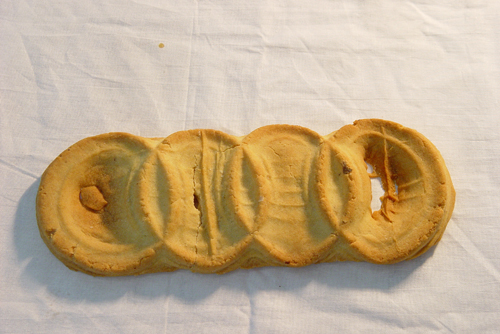卓凡的这些作品“有味道”。无论是糖和花生酱做的人头、面包做的手抢、白巧克力做的车牌,还是黑巧克力的AK-46,都发出一股诱人的香味,当然,牛油熬制的牛头味道更足,让人觉得鼻子的嗅觉太好使了。

中央美术学院 卓凡作品
这些作品看起来简单,不需要传承自米开朗基罗的手上绝活。但是,作品中或多或少体现出来的一丝颠覆性却让人禁不住有些沉思。首先,作品“颠覆”了惯常的材料,让观者有些措手不及。人们在脑海中几乎找不到与之相似的先例,从而失掉了对“艺术品”的判断力,旧有的固定艺术法则在这里失效了。其次,作品颠覆了雕塑家的形象,在厨房与展厅、面包房与艺术家工作室之间建立了透明的通道。雕塑家变成了食物加工者。总体来说,这些作品就像是一个“童话”,又像是一个“寓言”。作品的内涵可以有不同的解释。比如,巧克力的抢是否暗含政治揶揄?食物的车牌是否在对物质消费社会进行反讽?糖人头是否暗喻现代社会人际之间的相互吞噬?牛油做的牛头是否在对表象与本质进行沉思?等等。
作者本人也许自己并不局限于一种固定的解释。这些作品基本上有一个相同的特点,就是“复制”:用一种材料(比如糖)复制另一种材料(比如人头),用一种身份(比如雕塑家)复制另一种身份(比如面包师),用一种标准(吃)复制另一种标准(艺术)。如此一来,造就了作品的多义性,对观者和解释者提出了挑战,而最终结果是皆大欢喜:把它们吃掉吧!
(文)黄晓峰
The Stories of Food
Dr. Huang Xiaofeng, School of Humanity Science, China Central Academy of Fine Arts
These works by Mr. Zhuo Fan are “delicious”. They all emanate an inviting aroma: human head of sugar and peanut butter, bread pistol, white chocolate car number plate, black chocolate AK-46 and especially the fragrant bullhead of boiled butter, which makes our smell so acute.
The works appear simple and require no unmatched skill of Michelangelo. However, they reveal a sense of subversion that may leave us in deep thought. First of all, each piece of works greatly startle their audience by “subverting” the ordinary materials. Similar cases can hardly be found in our mind and thus our judgment is at a loss here. No archaic, rigid rules of art can be of use. Secondly, they subvert the image of the sculptor through building a transparent passage between the kitchen and the gallery, between the bakery house and the artist’s studio . The sculptor becomes a man who processes food. Generally speaking, these works are just like a fairy tale, or a “fable”. Each sculpture allows different interpretations. For example, does the chocolate gun imply a political teasing? Can the edible car number plate be a mockery of this materialized society? Is the sugar head a metaphor of the harsh reality of modern intercommunication? Is the butter bullhead a meditation on essence and phenomenon? Even the artist himself may not come to a single standard interpretation. These works share one similarity----reproduction: reproduction from one material (such as sugar) to another (such as head), from one identity (the sculptor) to another (the baker) and from one standard (cookery) to another (art). By doing so, the meaning of the work multiplies and becomes a challenge to the audience and the interpreter. No matter what the interpretation could be, it will ultimately lead to a happy ending: let’s eat them up!
|